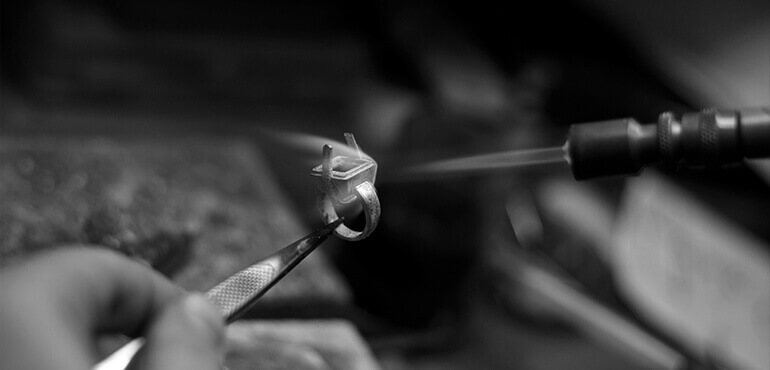Color Grade

At A Glance
- A diamonds color refers to its lack of color or the whiteness of a diamond.
- D is the highest grade possible and Z is the lowest.
- Torosi only sells diamonds with a color grade of () or higher.

What is a diamonds color grade?
A diamonds color is actually referring to its lack of color. Contrary to what you might think, most diamonds aren't colorless, but rather have slight hints of yellow or brown. Mostly this is undetectable to the naked eye or at least not obvious unless placed next to a higher grade diamond. Only very rare diamonds are truly colorless, thus we evaluate a diamonds worth based on the absence of color. The less color a diamond has, the more valuable it is. The gradient starts with colorless diamonds, the top grade being D, colorless, and then proceeding alphabetically with increasing color to the lowest grade Z, light yellow or brown.

diamond colors
D
Completely Colorless. The highest color grade possible, D ensures the diamond is completely colorless without any hints of color to the naked eye or under professional inspection. These diamonds are extremely rare and a magnificent specimen, as they are the purest in color that you can find. The purity of these diamonds is truly brilliant, containing absolutely no color. D is an exceptional grade and the ideal choice as it is the highest color grade, guaranteeing you the very best.
E-F
Colorless. E-F ensures the diamond is completely colorless to the naked eye. However, minute traces of color do exist within the diamond, though they can only be detected upon professional inspection by an expert gemologist. Diamonds of this color grade are rare and truly extraordinary in their beauty, as the absence of color makes them exemplary diamonds. E-F is an excellent color grade choice that offers tremendous value and quality.
G-H
Near-colorless. The color grade G-H describes a diamond that is near-colorless. When looked upon by the naked eye, these diamonds will appear colorless to the untrained eye. However, traces of color do exist within the diamond and have been detected by an expert gemologist. The color of these diamonds will not be apparent to the naked eye unless compared side by side to diamonds with higher color grades. Diamonds of this color grade are beautiful, with nearly undetectable color to them. G-H is a very good color grade choice that offers remarkable value.
I-J
Near-colorless. The color grade I-J describes a diamond that is near-colorless with a slight tint or warm hue present. When looked upon by the naked eye, these diamonds will appear mostly colorless to the untrained eye except for a slight warmth or tone to them. Traces of color are visible within the diamond and it is detectable by expert gemologists or other industry professionals. The color of these diamonds will become more noticeable if compared side by side to diamonds with higher color grades. Diamonds of this color grade are beautiful, with nearly undetectable color to them. I-J is a good color grade choice that offers tremendous value.
K-M
Noticeable Color. The color grade K-M describes a diamond that has a faint yellow tint, growing more predominant as you descend in grades. When looked upon by the naked eye, these diamonds will have very faint yellow hue to them. The color of these diamonds will become most apparent if compared side by side to diamonds with higher color grades, otherwise the faint yellow color will mostly appear as a soft hue. Diamonds of this color grade are beautiful, with slight color to them. K-M is a fair color grade choice.
N-Z
Noticeable Color. The color grade N-Z describes a diamond that has a yellow tint, growing more predominant as you descend in grades. When looked upon by the naked eye, the diamonds yellow hue will be evident. The color of these diamonds will become most apparent if compared side by side to diamonds with higher color grades. Diamonds of this color grade are still attractive, but the color is obvious. N-Z is a poor color grade choice.
When selecting a diamond, color grade is generally considered to be the second most important characteristic after cut. For every letter grade, there is a clear definition of the range of color appearance. A diamond's color grade is determined by comparing a diamonds colorlessness to stones of established color value under controlled lighting and precise viewing conditions. Since a diamond's color is a result of its composition, it never changes over time. Due to the formation process of diamonds, a truly colorless diamond is extremely rare. Colorless diamonds are like a clear window, allowing more light to pass through them than a diamond that does have remnants of color. Thus colorless diamonds emit more fire and sparkle, which is the crucial element behind their greater value.
(Note: However, this does not pertain to colored or Fancy Color Diamonds, which are further discussed in the Fancy Color Diamonds section of this Diamond Education Guide. Extremely rare and expensive, Fancy Color Diamonds range in any color from blue, bright yellow, red, green and more; variations of each color in between to create a kaleidoscope of choices. Contrary to white diamonds, their color is what makes them more valuable.)
What color grade is right for me?
When choosing a color grade that's right for you, you should take into consideration your price range and the metal type that the diamond will be set in. For instance, if your setting is either platinum or white gold, a higher grade is likely best due to the way it would emphasis hints of color in the diamond. While if your setting is yellow gold, color would be harder to detect. Though many will purchase the most colorless diamond they can afford, a lot of people actually prefer the warmer glow of lower grade diamonds. Ultimately, it's about finding the diamond that's right for you.
Naturally, diamonds graded D through F, are colorless and the most valuable for their rarity. Although not graded colorless, diamonds G through I are near colorless in grade and to the naked, untrained eye show virtually no color. Thus, you can still find great value in many of the color grades available.
What is Diamond Fluorescence?
When gem-quality diamonds are exposed to long-wave ultraviolet light, fluorescence is an effect that manifests. Fluorescence is not discernible to the naked eye under most lighting conditions. However, while some people enjoy it, most gemologists prefer diamonds without this effect. Despite its affect on the pricing of diamonds, studies have shown that it does not affect the appearance of a diamond. You can learn more in the Diamond Fluorescence section.









 Three Stone Rings
Three Stone Rings Side Stone Rings
Side Stone Rings Halo Rings
Halo Rings Vintage Rings
Vintage Rings Solitaire Rings
Solitaire Rings Yellow Gold Rings
Yellow Gold Rings White Gold Rings
White Gold Rings Pave Rings
Pave Rings Channel Rings
Channel Rings Simple Rings
Simple Rings Round Rings
Round Rings Princess Rings
Princess Rings Cushion Rings
Cushion Rings Emerald Rings
Emerald Rings Asscher Rings
Asscher Rings Radiant Rings
Radiant Rings Oval Rings
Oval Rings Pear Rings
Pear Rings Marquise Rings
Marquise Rings Heart Rings
Heart Rings 14k White Gold
14k White Gold 14k Yellow Gold
14k Yellow Gold 18k White Gold
18k White Gold 18k Yellow Gold
18k Yellow Gold Platinum
Platinum Channel Bands
Channel Bands Pave Bands
Pave Bands Prong Bands
Prong Bands Eternity Bands
Eternity Bands Diamond Bands
Diamond Bands
